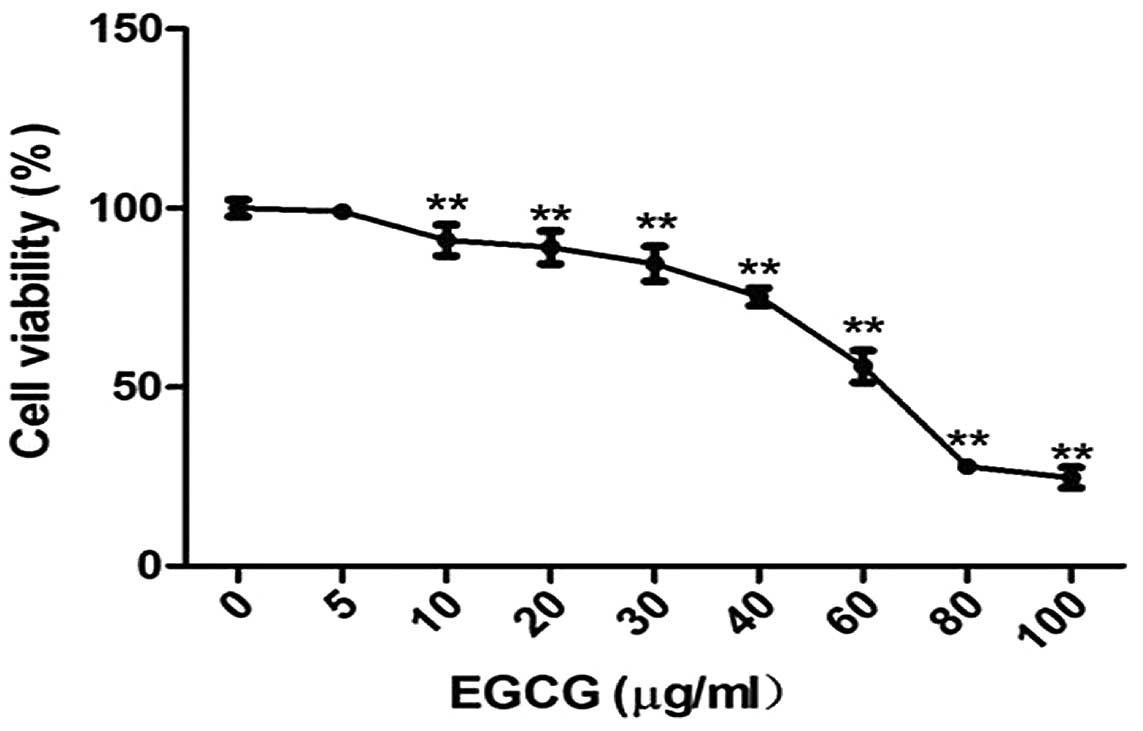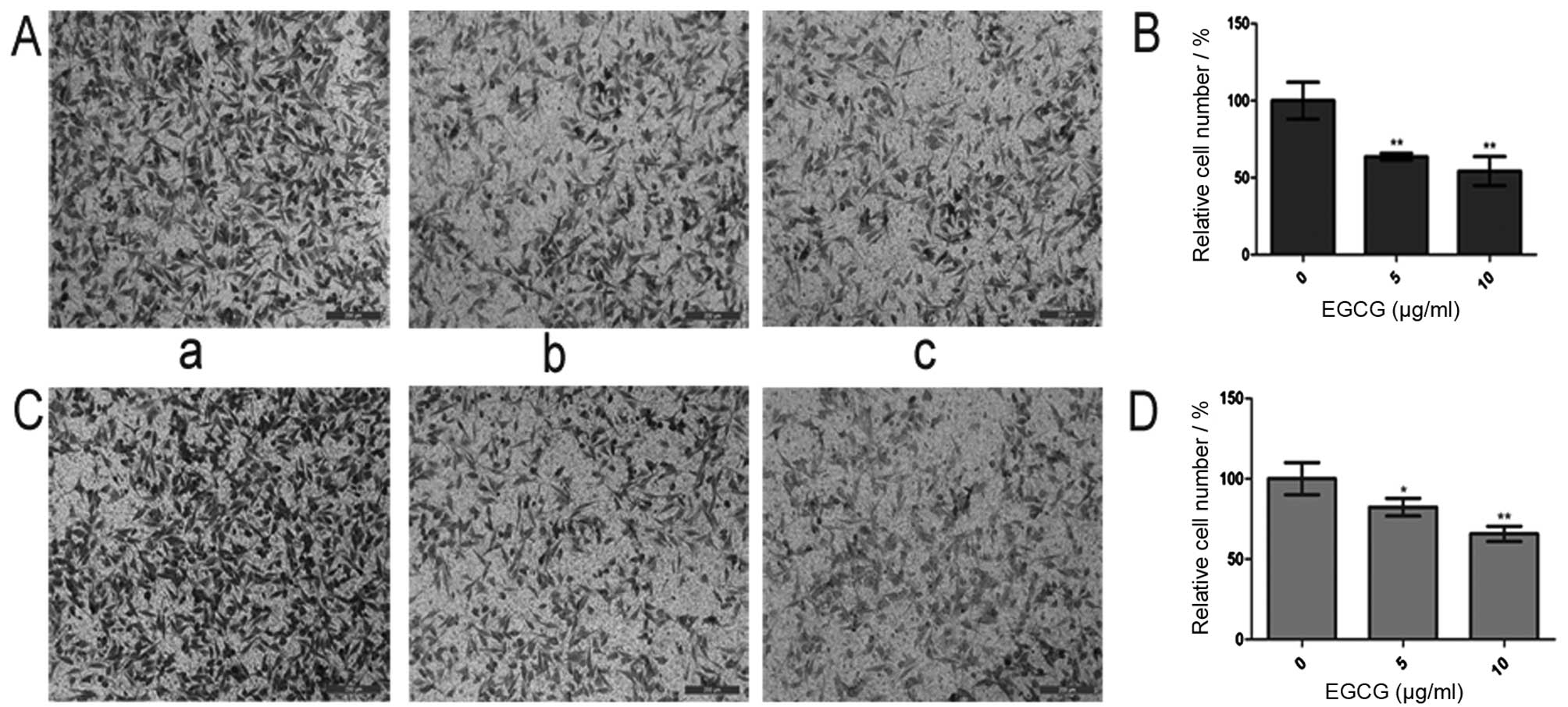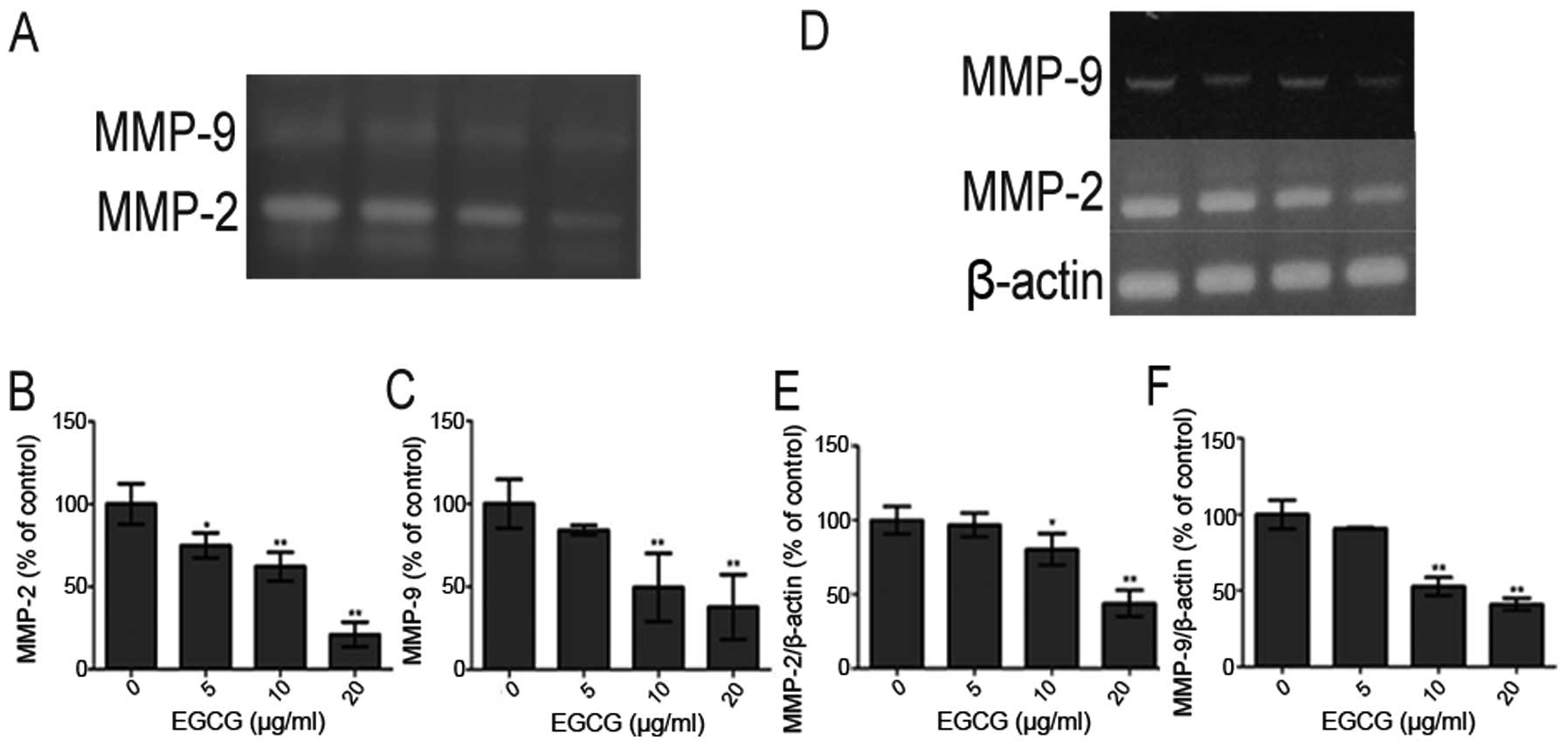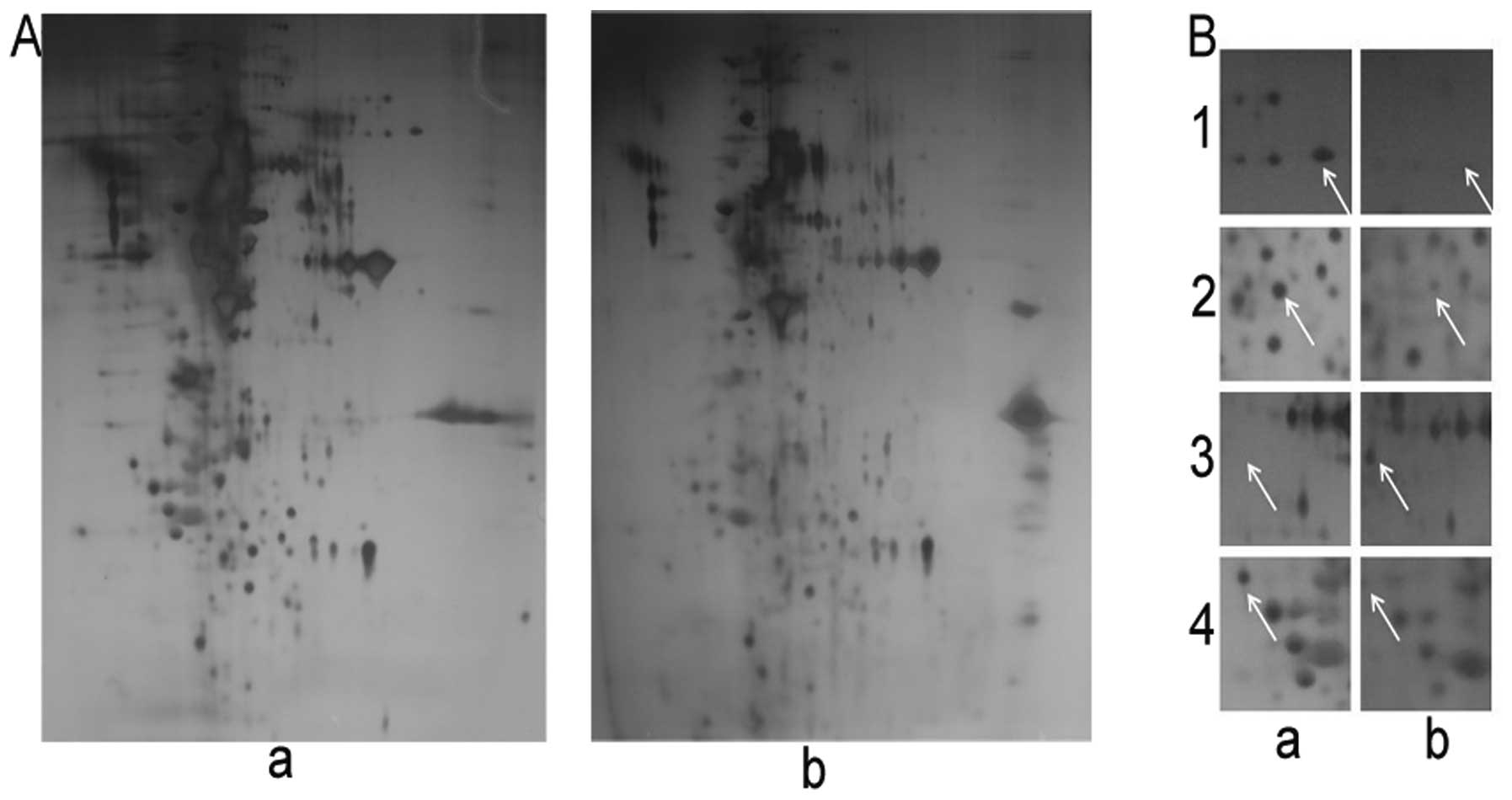Anti-metastatic and differential effects on protein expression of epigallocatechin-3-gallate in HCCLM6 hepatocellular carcinoma cells
- Authors:
- Published online on: July 16, 2013 https://doi.org/10.3892/ijmm.2013.1446
- Pages: 959-964
Abstract
Introduction
Hepatocellular carcinoma (HCC) is the fifth most common cancer worldwide and the third highest cause of cancer-related mortality (500,000 deaths annually) (1). HCC is a primary malignant tumor of the liver with high prevalence in Asia and Africa (2). There are a number of different therapies for the treatment of HCC, including percutaneous ethanol injection therapy (PEIT), transcatheter arterial chemoembolization (TACE), liver transplantation and surgical intervention. Of these, surgical intervention has been the most effective therapy for improving the survival of patients (3). Nevertheless, only a small subset of HCC patients increase their 5-year survival rate by surgical resection, primarily due to the high rate of metastasis and the expression of anti-apoptotic genes associated with HCC (4,5). Therefore, metastasis remains the major obstacle to the development of optimal treatment methods for HCC, and novel or adjunct therapeutic strategies are paramount to overcoming this obstacle.
Tea is the most widely consumed beverage worldwide; furthermore, green tea is sold on a large scale, in part, due to its chemotherapeutic value (6,7). Catechins constitute approximately 40% of the dry weight of green tea, and epigallocatechin-3-gallate (EGCG), a polyphenol, constitutes the highest percentage among the catechins (8–10). EGCG has immense potential as a therapeutic agent for the treatment and/or prevention of cancer due to its low cost and high bioavailability (11). The anticancer role of EGCG has been investigated epidemiologically, in in vitro and in vivo models, as well as in clinical trials (12–14). In vitro studies have demonstrated the inhibitory effects of EGCG on cancer by suppressing metastasis (13,15,16). There is also a large body of evidence demonstrating the effects of EGCG on the migration ability of several human cancer cell lines by a multifactorial mechanism involving the downregulation of matrix metalloproteinases (MMPs) (15,17). Yet, the precise mechanisms of action of EGCG as an anticancer agent remain unknown.
To our knowledge, the potential effects of EGCG on HCCLM6, a human HCC metastatic cell line, have not been previously reported. Thus, in this study, we investigated the effects and molecular mechanisms of action of EGCG in HCCLM6 cells as a novel and/or adjunct therapeutic agent in the treatment of HCC.
Materials and methods
Antibodies and reagents
EGCG (≥98% purity), 3-(4,5-dimethylthiazol-2-yl)-2,5-diphenyltetrazolium bromide (MTT) and gelatin were purchased from Sigma (St. Louis, MO, USA). The RNA PCR kit (AMV) was purchased from the Takara Biotechnology Co., Ltd. (Dalian, China). DMEM and fetal bovine serum (FBS) were purchased from Gibco (Grand Island, NY, USA). TRIzol was purchased from Invitrogen (Camarillo, CA, USA). The Pierce® SilverStain for Mass Spectrometry kit was purchased from Thermo Scientific (Rockford, IL, USA). Immobilized pH gradient (IPG) strips and the 2-D Cleanup kit were purchased from Bio-Rad (Hercules, CA, USA). The BCA protein assay kit was purchased from KeyGen Biotech. Co. Ltd. (Nanjing, China), and 24-well, double-compartment Transwell plates were purchased from Corning Inc. (Lowell, MA, USA).
Cells and culture
HCCLM6 cells (ATCC, Manassas, VA, USA) were grown in DMEM supplemented with 10% heat-inactivated FBS, 0.1% benzyl penicillin and streptomycin. Cells were maintained at 37°C in a humidified incubator with an atmosphere of 5% CO2.
Cell viability assay
HCCLM6 cells (6×103 cells/well) were plated in 96-well plates for 12 h. The cells were treated with various concentrations (0, 5, 10, 20, 30, 40, 50, 60, 80 or 100 μg/ml) of EGCG and incubated for an additional 24 h. At the end of the treatment, the culture medium was replaced with fresh complete medium containing 0.5 mg/ml MTT and incubated at 37°C for 4 h. Following incubation, the medium was discarded, and DMSO was added to the wells and gently agitated for 10 min. The absorbance was then measured at 490 nm. The assay was repeated at least 3 times. The cell growth inhibition rates were calculated according to the following formula: inhibition rate (%) = (1 − mean absorbance of treated group/mean absorbance of untreated group) ×100%.
In vitro migration and invasion assays
The 24-well Transwell plates and 8.0 μm pore filter inserts (Corning Inc.) were used for the migration and invasion assays according to the standard Boyden Chamber protocol. Briefly, HCCLM6 cells were seeded in a 6-well plate, and at 80% confluency, the cells were treated with 0, 5 or 10 μg/ml EGCG and incubated for 18 h. The cells were harvested, counted and diluted to 5×105/ml of viable cells in medium without FBS. The cell suspension (0.2 ml) was placed on top of the filter of the upper chamber, and 0.6 ml of complete medium was placed in the lower chamber. The filter insert was placed into the lower chamber and incubated for 18 h at 37°C. Non-migrated cells were removed from the top side of the filter by scrubbing with a cotton-tipped swab moistened with FBS-free medium. Migrated cells on the underside of the filter were fixed in 20% methanol for 20 min, stained with 0.1% crystal violet at 37°C for 30 min and then washed with PBS. The invasion assay was carried out as described above, except that the top side of the filter membrane was pre-coated with 50 μl of Matrigel (0.3 mg/50 μl; Bio-Rad) and incubated for 5 h at 37°C to allow the matrix to form a gel before seeding the cells onto it. Stained cells were photographed at ×200 magnification using a Nikon camera fitted to a Leica microscope (Leica Microsystems, Wetzlar, Germany).
Gelatin zymography
The HCCLM6 cells (1×105) were seeded in a 6-well plate. At 80% confluency, the cells were treated with 0, 5, 10 or 20 μg/ml EGCG and incubated for 18 h. Following incubation, the cells and medium were harvested and centrifuged (1,000 rpm for 5 min) to collect the supernatant. The supernatants from the samples were normalized to the cell number and electrophoresed on a 10% polyacrylamide gel containing 1 mg/ml gelatin at 4°C. Following electrophoresis, the gels were washed for 15 min in 2.5% Triton X-100 4 times at room temperature and then incubated for 24 h at 37°C in activation buffer (50 mM Tris-HCl, pH 7.5; 5 mM CaCl2; 10 mM NaCl; 10 mM ZnCl2). The gels were stained with 0.2% coomassie brilliant blue (Ameresco Co., Framingham, MA, USA) for 3 h and then destained in destaining buffer (30% methanol, 10% acetic acid) until the gelatinolytic activity of the MMPs are visible.
RT-PCR
The HCCLM6 cells (3×105) were seeded in 6-well plates until they reached 80% confluency. The cells were treated with 0, 5, 10 and 20 μg/ml EGCG or 0, 10 and 30 μg/ml EGCG and incubated for 20 h. Total RNA was extracted with TRIzol according to the manufacturer’s instructions (Invitrogen). Semi-quantification and purity assessment were performed by optical density (OD) measurements at 260 and 280 nm. cDNA was synthesized from the total RNA using an RNA PCR kit (Takara Biotechnology Co., Ltd.). The primers were derived from human sequences (Table I), and the PCR conditions were optimized until the gene products were within the linear phase of PCR amplification. The PCR products were resolved on 1% (w/v) agarose gels containing ethidium bromide. The results were normalized to β-actin. The PCR conditions for each target gene (MMP-2, MMP-9 and β-actin) were as follows: 95°C for 5 min; 30 cycles of 95°C for 30 sec, 55°C for 30 sec and 72°C for 30 sec; 72°C for 10 min.
Proteomic analysis of EGCG-treated cells
The HCCLM6 cells were plated as described above and treated with EGCG (0 or 20 μg/ml). Total protein was extracted and pre-treated with the 2-D Cleanup kit (Bio-Rad). Isoelectrofocusing (IEF) was performed using 7 cm IPG strips (Bio-Rad) with an immobilized pH gradient from 3–10. The strips were rehydrated at room temperature for 16 h with 125 μl of swelling buffer (8 mol/l urea, 2% CHAPS, 2% IPG buffer, 0.3% DTT and a trace of bromophenol blue), which contained 45 μg of pre-treated proteins from either the EGCG-treated or untreated cells. IEF was performed at 200 V for 20 min, 450 V for 15 min, 750 V for 15 min and 3,000 V for 2 h. Following IEF, the strips were immediately equilibrated with the equilibrium sample buffer (50 mmol/l Tris-HCl, pH 8.8; 6 mol/l urea; 30% glycerol; 2% SDS; and a trace of bromophenol blue) at room temperature for 30 min with gentle shaking. SDS-PAGE was performed using 12% SDS-polyacrylamide gels. The strips were held in place with 0.5% agarose dissolved in SDS running buffer, and electrophoresis was then performed (5 mA for 20 min, 15 mA for 20 min, 20 mA for 20 min, and 30 mA in 4°C for 2 h). The gels were stained with the Silver Stain for Mass Spectrometry kit (Thermo Scientific) according to the manufacturer’s instructions. Image analysis was performed using the PDQuest system (Bio-Rad). The selected spots were excised, and the proteins were purified by an in-gel digestion with trypsin. The resulting peptides were subjected to analysis by matrix-assisted laser desorption/ionization-time of flight mass spectrometry (MALDI-TOF/MS).
Statistical analysis
The results of all the experiments are expressed as the means ± SD. Statistical analyses were performed using SPSS 13.0 software. A P-value <0.05 was considered to indicate a statistically significant difference.
Results
Effects of EGCG on cell viability
To determine the effect of EGCG on HCC, HCCLM6 cells were treated with EGCG at concentrations varying between 5 and 100 μg/ml. EGCG (10–100 μg/ml) significantly inhibited the growth of HCCLM6 cells in a dose-dependent manner (Fig. 1) (P<0.01). These results indicate that EGCG inhibits cell growth (or induces apoptosis) in the HCC cell line, HCCLM6.
Effects of EGCG on cell migration and invasion
As indicated in Materials and methods, the 24-well Transwell membrane inserts had pores large enough to accommodate the migration (and/or the invasion) of single cells. The cells invading the underside of the 24-well Transwell membrane in these assays were fixed and stained (Fig. 2A and C). The cell migration analysis of HCCLM6 cells showed significantly lower (P<0.01) migration in the 5 and 10 μg/ml EGCG-treated cells compared with the untreated cells (Fig. 2B). The cell invasion analysis of HCCLM6 cells showed significantly lower (P<0.01) invasion in the 5 and 10 μg/ml EGCG-treated cells compared with the untreated cells (Fig. 2D).
Effect of EGCG on MMP-2 and MMP-9 activity
Gelatin zymography analysis indicated that treatment with EGCG significantly inhibited the activity of MMP-2 and MMP-9 in the conditioned medium of HCCLM6 cells (Fig. 3A). The activity of MMP-2 and MMP-9 decreased in a dose-dependent manner with the increasing EGCG concentration (Fig. 3B and C, respectively).
Effect of EGCG on MMP-2 and MMP-9 gene expression
To determine the effects of EGCG on the mRNA levels of MMP-2 and MMP-9 genes, the HCCLM6 cells (1×106 cells/ml) were maintained in culture with or without EGCG for 24 h. Total RNA was isolated for RT-PCR as described above. As shown in Fig. 3D, the mRNA levels of MMP-2 and MMP-9 were downregulated in a dose-dependent manner by EGCG (Fig. 3E and F, respectively).
Proteomic analysis of EGCG-treated cells
The proteins from the EGCG-treated or untreated HCCLM6 cells were separated by 2-dimensional gel electrophoresis (2-DE) according to their isoelectric points and molecular weights. The 2-DE gels represent the pattern of all the proteins in the untreated and EGCG-treated HCCLM6 cells (Fig. 4A). Of the proteins whose expression was significantly altered by EGCG treatment, 10 were selected (data not shown) and analyzed by MALDI-TOF/MS. Using bioinformatics mining with the MASCOT search engine (http://www.matrixscience.com/) and NCBI BLASTP (http://www.ncbi.nlm.nih.gov/blast), we determined significant functional differences (Table II) in 4 of these proteins (Fig. 4B).
Table IICharacteristics of the 4 proteins with significant functional differences and their relative expression levels in HCCLM6 cells treated with EGCG. |
Discussion
In this study, EGCG exhibited anticancer effects by clearly inhibiting the metastatic potential (migration and invasion) of HCCLM6 cells. MMP-2 and MMP-9 expression and enzyme activity correlated with the EGCG inhibition of metastasis, suggesting that EGCG prevents metastasis by inhibiting these enzymes (18). EGCG has been shown to inhibit tumor invasion and migration associated with MMPs in human breast cancer and pancreatic cancer cells (15,19). Metastasis, the spread of cancer in the body, is a major cause of mortality (19). Collagenase type IV (containing MMP-2 and MMP-9) is a key enzyme involved in tumor invasion and migration, as demonstrated by the anti-metastatic effects of several collagenase inhibitors; some inhibitors have already been used in clinical trials (20). In our study, EGCG significantly inhibited HCCLM6 cell metastasis in a dose-dependent manner at both the mRNA expression and protein (enzyme) activity levels (Figs. 3 and 4). These results suggest that EGCG inhibits the metastasis of HCCLM6 cells through the downregulation of MMPs.
To further understand the effects of EGCG on HCCLM6 cells and to identify potential novel therapeutic targets for HCC, the protein profiles of EGCG-treated and untreated cells were analyzed. We identified 4 proteins associated with cell growth and proliferation: far upstream element binding protein 1 (FUBP1), heat shock protein (HSP)B1, heat shock 60 kDa protein 1 (chaperonin) (CH60) and nucleophosmin (NPM) (Table II). FUBP1 is a DNA binding protein that activates the far upstream element of c-Myc to stimulate its expression in HCC (21,22). FUBP1 functions as an ATP-dependent DNA helicase, which is overexpressed in soft tissue metastasis, and has been shown to be an important element in the progression of breast cancer metastasis (23). Therefore, FUBP1 may be an important component in the overall metastatic process of HCC. Panel 1 of Fig. 4B shows the decreased expression of FUBP1 protein following treatment with EGCG. EGCG anti-metastatic activity in HCCLM6 and in HCC, in general, may involve FUBP1 through a molecular mechanism similar to that proposed in other soft tissues (23).
HSPB1, also known as HSP27, belongs to the ubiquitous family of small HSPs. In panel 2 of Fig. 4B, the enlarged 2-DE gel image shows a significant reduction in HSPB1 expression following treatment with EGCG. In MDA-MB-231 breast cancer cells, increased HSPB1 expression has been shown to enhance metastasis through the upregulation of MMP-9 (24,25). HSP27 is a potent therapeutic target in breast cancer bone metastasis; the anti-metastatic agent, midazolium trans-imidazole dimethyl sulfoxide tetrachlororuthenate (NAMI-A), has been shown to decrease HSP27 protein expression (26). In the present study, we hypothesized that treatment with EGCG may have decreased HSP27 expression by downregulating MMP-9 and reducing HCCLM6 cancer cell metastasis (Table II and Fig. 3).
NPM is a multifunctional protein that shuttles between the nucleoli and the cytoplasm, functioning as a chaperone for the nuclear export of ribosomal subunits (27,28). NPM shifts its location from the nucleolus to the nucleoplasm (NPM translocation) and accumulates if cells are exposed to actinomycin D, doxorubicin, or other DNA damaging agents (29,30). In our study, treatment with EGCG significantly increased NPM expression in HCCLM6 cells (Fig. 4B, panel 3). HeLa cells exposed to long-term and/or to high doses of actinomycin D (or other antibiotics with anticancer activity) have shown a significant accumulation of NPM in the nucleoplasm, which antagonizes both cell growth and RNA synthesis (29). EGCG may impair RNA synthesis, RNA processing and cell growth due to a loss of NPM binding targets in the nucleolus, which may cause it to accumulate in the nucleoplasm. The resulting loss of ribosomal assembly integrity may inhibit cellular growth (and/or metastasis) in HCCLM6 cells. In a recent study, increased NPM expression levels were suggested to enhance cellular transformation, antagonize the repression of cell adhesion genes and inhibit apoptosis mediated by the Myc-Miz1 complex if the alternate reading frame (Arf) tumor suppressor protein is present (31). These contradicting observations of NPM expression in cancer require further investigation to clearly define the ‘antagonistic’ function of this protein, either enhancing or reducing carcinogenesis and/or tumor progression.
CH60 has been associated with tumor metastasis by regulating tumor immunity (32,33). The overexpression of HSP60 has been shown to increase the migration and invasive potential of human pharyngeal squamous carcinoma cells (FADU cells) in vitro and in vivo (34). The enlargement of the 2-DE gel in panel 4 of Fig. 4B shows a significant loss of CH60 expression in the HCCLM6 cells following treatment with EGCG. CH60 may be a critical factor in the anti-metastatic activity of EGCG in HCCLM6 cells.
The present study demonstrates that EGCG inhibits HCCLM6 cell metastasis by inhibiting MMP-2, MMP-9, FUBP1, HSPB1 and CH60 expression and increasing NPM expression. However, further studies are required to investigate the specific anti-metastatic mechanisms of action of EGCG and its effects on FUBP1, HSPB1, NPM and CH60 expression in cells in vitro and in vivo. Nevertheless, the data from the present study suggest that EGCG has potential as an anticancer agent in the treatment of HCC.
Abbreviations:
|
HCC |
hepatocellular carcinoma |
|
EGCG |
epigallocatechin-3-gallate |
|
2-DE |
2-dimensional gel electrophoresis |
|
MTT |
3-(4,5-dimethylthiazol-2-yl)-2,5-diphenyltetrazolium bromide |
References
|
Parkin DM, Bray F, Ferlay J and Pisani P: Estimating the world cancer burden: Globocan 2000. Int J Cancer. 94:153–156. 2001. View Article : Google Scholar : PubMed/NCBI | |
|
El-Serag HB and Mason AC: Rising incidence of hepatocellular carcinoma in the United States. N Engl J Med. 340:745–750. 1999. View Article : Google Scholar : PubMed/NCBI | |
|
Ikai I, Yamaoka Y, Yamamoto Y, et al: Surgical intervention for patients with stage IV-A hepatocellular carcinoma without lymph node metastasis: proposal as a standard therapy. Ann Surg. 227:433–439. 1998. View Article : Google Scholar : PubMed/NCBI | |
|
Lee JS, Chu IS, Heo J, Calvisi DF, et al: Classification and prediction of survival in hepatocellular carcinoma by gene expression profiling. Hepatology. 40:667–676. 2004. View Article : Google Scholar : PubMed/NCBI | |
|
Song HY, Liu YK, Feng JT, et al: Proteomic analysis on metastasis-associated proteins of human hepatocellular carcinoma tissues. J Cancer Res Clin Oncol. 132:92–98. 2006. View Article : Google Scholar : PubMed/NCBI | |
|
Shukla Y: Tea and cancer chemoprevention: a comprehensive review. Asian Pacific J Cancer Prev. 8:155–165. 2007.PubMed/NCBI | |
|
Yang CS, Wang X, Lu G and Picinich SC: Cancer prevention by tea: animal studies, molecular mechanisms and human relevance. Nat Rev Cancer. 9:429–439. 2009. View Article : Google Scholar : PubMed/NCBI | |
|
Yang CS and Wang ZY: Tea and cancer. J Natl Cancer Inst. 85:1038–1049. 1993. View Article : Google Scholar | |
|
Balentine DA, Wiseman SA and Bouwens LCM: The chemistry of tea flavonoids. Crit Rev Food Sci Nutr. 37:693–704. 1997. View Article : Google Scholar : PubMed/NCBI | |
|
Mukhtar H and Ahmad N: Green tea in chemoprevention of cancer. Toxicol Sci. 52:111–117. 1999. View Article : Google Scholar : PubMed/NCBI | |
|
Singh BN, Shankar S and Srivastava RK: Green tea catechin, epigallocatechin-3-gallate (EGCG): mechanisms, perspectives and clinical applications. Biochem Pharmacol. 82:1807–1821. 2011. View Article : Google Scholar : PubMed/NCBI | |
|
Thawonsuwan J, Kiron V, Satoh S, et al: Epigallocatechin-3-gallate (EGCG) affects the antioxidant and immune defense of the rainbow trout, Oncorhynchus mykiss. Fish Physiol Biochem. 36:687–697. 2010. View Article : Google Scholar : PubMed/NCBI | |
|
Mukhtar H and Ahmad N: Tea polyphenols: prevention of cancer and optimizing health. Am J Clin Nutr. 71(Suppl 6): S1698–S1702. 2000.PubMed/NCBI | |
|
Thangapazham RL, Singh AK, Sharma A, et al: Green tea polyphenols and its constituent epigallocatechin gallate inhibits proliferation of human breast cancer cells in vitro and in vivo. Cancer Lett. 245:232–241. 2007. View Article : Google Scholar : PubMed/NCBI | |
|
Shankar S, Ganapathy S, Hingorani SR and Srivastava RK: EGCG inhibits growth, invasion, angiogenesis and metastasis of pancreatic cancer. Front Biosci. 13:440–452. 2008. View Article : Google Scholar : PubMed/NCBI | |
|
Stuart EC, Scandlyn MJ and Rosengren RJ: Role of epigallocatechin gallate (EGCG) in the treatment of breast and prostate cancer. Life Sci. 79:2329–2336. 2006. View Article : Google Scholar : PubMed/NCBI | |
|
Sen T, Moulik S, Dutta A, et al: Multifunctional effect of epigallocatechin-3-gallate (EGCG) in downregulation of gelatinase-A (MMP-2) in human breast cancer cell line MCF-7. Life Sci. 84:194–204. 2009. View Article : Google Scholar : PubMed/NCBI | |
|
Lee SJ, Lee KW, Hur HJ, Chun JY, Kim SY and Lee HJ: Phenolic phytochemicals derived from red pine (Pinus densiflora) inhibit the invasion and migration of SK-Hep-1 human hepatocellular carcinoma cells. Ann NY Acad Sci. 1095:536–544. 2007.PubMed/NCBI | |
|
Woodhouse EC, Chuaqui RF and Liotta LC: General mechanisms of metastasis. Cancer. 80(Suppl 8): S1529–S1537. 1997. View Article : Google Scholar | |
|
Hidalgo M and Eckhardt SG: Development of matrix metalloproteinase inhibitors in cancer therapy. J Natl Cancer Inst. 93:178–193. 2001. View Article : Google Scholar : PubMed/NCBI | |
|
Duncan R, Bazar L, Michelotti G, Tomonaga T, Krutzsch H, Avigan M and Levens D: A sequence-specific, single-strand binding protein activates the far upstream element of c-myc and defines a new DNA-binding motif. Genes Dev. 8:465–480. 1994. View Article : Google Scholar | |
|
Zubaidah RM, Tan GS, Tan SB, Lim SG, Lin Q and Chung MC: 2-D DIGE profiling of hepatocellular carcinoma tissues identified isoforms of far upstream binding protein (FUBP) as novel candidates in liver carcinogenesis. Proteomics. 8:5086–5096. 2008. View Article : Google Scholar | |
|
Sanz R, Aragüés R, Stresing V, Martín B, Landemaine T, Oliva B, et al: Functional pathways shared by liver and lung metastases: a mitochondrial chaperone machine is up-regulated in soft-tissue breast cancer metastasis. Clin Exp Metastasis. 24:673–683. 2007. View Article : Google Scholar : PubMed/NCBI | |
|
Hansen RK, Parra I, Hilsenbeck SG, Himelstein B and Fuqua SA: Hsp27-induced MMP-9 expression in influenced by the Src tyrosine protein kinase yes. Biochem Biophys Res Commun. 282:186–193. 2001. View Article : Google Scholar : PubMed/NCBI | |
|
Gibert B, Eckel B, Gonin V, Goldschneider D, Fombonne J, Deux B, et al: Targeting heat shock protein 27 (HspB1) interferes with bone metastasis and tumour formation in vivo. Br J Cancer. 107:63–70. 2012. View Article : Google Scholar : PubMed/NCBI | |
|
Sanna B, Debidda M, Pintus G, et al: The anti-metastatic agent imidazolium trans-imidazoledimethylsulfoxide-tetrachlororuthenate induces endothelial cell apoptosis by inhibiting the mitogen-activated protein kinase/extracellular signal-regulated kinase signaling pathway. Arch Biochem Biophys. 403:209–218. 2002. View Article : Google Scholar | |
|
Borer RA, Lehner CF, Eppenberger HM and Nigg EA: Major nucleolar proteins shuttle between nucleus and cytoplasm. Cell. 56:379–390. 1989. View Article : Google Scholar : PubMed/NCBI | |
|
Maggi LB Jr, Kuchenruether M, Dadey DY, Schwope RM, Grisendi S, Townsend RR, et al: Nucleophosmin serves as a rate-limiting nuclear export chaperone for the Mammalian ribosome. Mol Cell Biol. 28:7050–7065. 2008. View Article : Google Scholar : PubMed/NCBI | |
|
Yung BY, Bor AM and Chan PK: Short exposure to actinomycin D induces ‘reversible’ translocation of protein B23 as well as ‘reversible’ inhibition of cell growth and RNA synthesis in HeLa cells. Cancer Res. 50:5987–5991. 1990. | |
|
Chan PK and Chan FY: A study of correlation between NPM-translocation and apoptosis in cells induced by daunomycin. Biochem Pharmacol. 57:1265–1273. 1999. View Article : Google Scholar : PubMed/NCBI | |
|
Herkert B, Dwertmann A, Herold S, Abed M, Naud JF, Finkernagel F, et al: The Arf tumor suppressor protein inhibits Miz1 to suppress cell adhesion and induce apoptosis. J Cell Biol. 188:905–918. 2010. View Article : Google Scholar : PubMed/NCBI | |
|
Feng Y, Tian ZM, Wan MX and Zheng ZB: Protein profile of human hepatocarcinoma cell line SMMC-7721: identification and functional analysis. World J Gastroenterol. 13:2608–2614. 2007. View Article : Google Scholar : PubMed/NCBI | |
|
Jiang D, Ying W, Lu Y, Wan J, Zhai Y, Liu W, et al: Identification of metastasis-associated proteins by proteomic analysis and functional exploration of interleukin-18 in metastasis. Proteomics. 3:724–737. 2003. View Article : Google Scholar : PubMed/NCBI | |
|
Tsai YP, Yang MH, Huang CH, et al: Interaction between HSP60 and beta-catenin promotes metastasis. Carcinogenesis. 30:1049–1057. 2009. View Article : Google Scholar : PubMed/NCBI |













